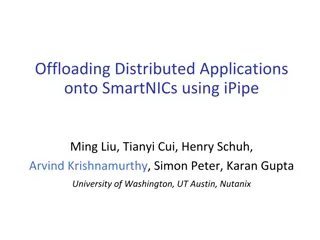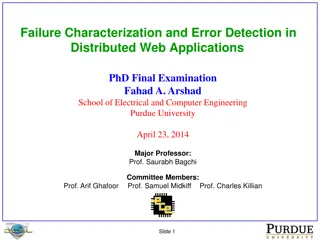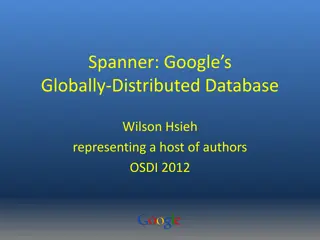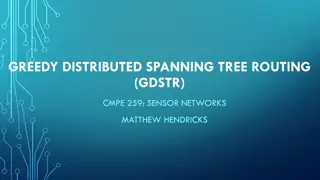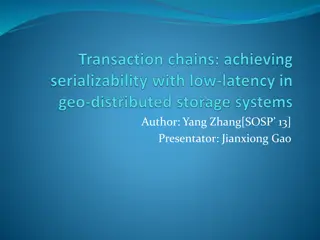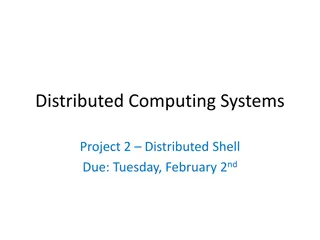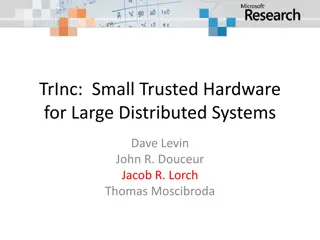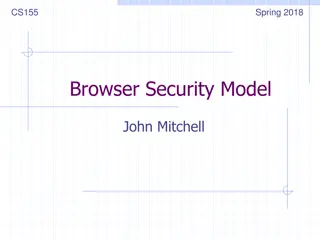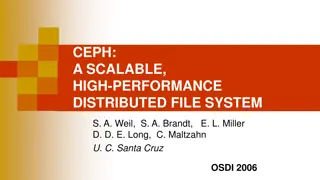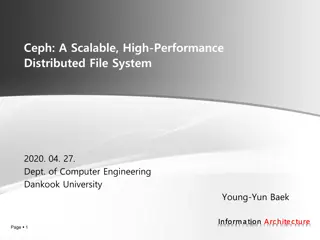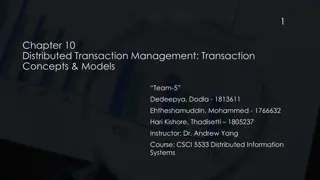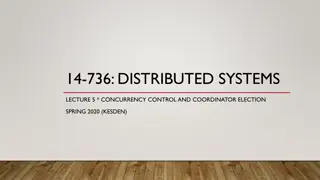Overview of Distributed Systems: Characteristics, Classification, Computation, Communication, and Fault Models
Characterizing Distributed Systems: Multiple autonomous computers with CPUs, memory, storage, and I/O paths, interconnected geographically, shared state, global invariants. Classifying Distributed Systems: Based on synchrony, communication medium, fault models like crash and Byzantine failures. Comp
9 views • 126 slides
Understanding Parallel and Distributed Computing Systems
In parallel computing, processing elements collaborate to solve problems, while distributed systems appear as a single coherent system to users, made up of independent computers. Contemporary computing systems like mobile devices, IoT devices, and high-end gaming computers incorporate parallel and d
1 views • 11 slides
Understanding REST API Basics and Traditional Web Applications
Explore the fundamental concepts of REST API and traditional web applications, including client-server interactions, the role of HTML and HTTP, drawbacks of traditional approaches, the significance of APIs, different types of web APIs, and the principles underlying Representational State Transfer (R
3 views • 21 slides
Understanding Remote Method Invocation (RMI) in Distributed Systems
A distributed system involves software components on different computers communicating through message passing to achieve common goals. Organized with middleware like RMI, it allows for interactions across heterogeneous networks. RMI facilitates building distributed Java systems by enabling method i
1 views • 47 slides
Understanding Parallel and Distributed Systems in Computing
A parallel computer is a collection of processing elements that collaborate to solve problems, while a distributed system comprises independent computers appearing as a single system. Contemporary computing systems, like mobile devices and cloud platforms, utilize parallel and distributed architectu
0 views • 11 slides
Distributed DBMS Reliability Concepts and Measures
Distributed DBMS reliability is crucial for ensuring continuous user request processing despite system failures. This chapter delves into fundamental definitions, fault classifications, and types of faults like hard and soft failures in distributed systems. Understanding reliability concepts helps i
0 views • 58 slides
SmartNIC Offloading for Distributed Applications
This presentation discusses offloading distributed applications onto SmartNICs using the iPipe framework. It explores the potential of programmable NICs to accelerate general distributed applications, characterizes multicore SmartNICs, and outlines the development and evaluation process. The study c
0 views • 31 slides
Understanding Internet Basics and Web Browsers
This content covers the basics of the Internet and World Wide Web, including the differences between the two, the functions of web browsers, components of Internet Explorer, parts of the World Wide Web, conducting effective Internet searches, understanding search results, evaluating websites, and di
0 views • 49 slides
Understanding Web Hosting and Server Types
Web hosting is a service that enables individuals and organizations to make their websites accessible via the World Wide Web. It provides necessary infrastructure, storage, and connectivity to ensure websites are available to users 24/7. The web hosting process involves domain names, DNS translation
0 views • 9 slides
Understanding Web Technologies and Internet Standards
Web technologies encompass various tools and techniques used for communication between devices over the internet. It includes web browsers, programming languages, databases, protocols, multimedia elements, and data formats. The World Wide Web (WWW) plays a pivotal role in connecting networks globall
3 views • 35 slides
Understanding Web Accessibility and Its Importance
Web accessibility ensures that websites are designed to be inclusive and accessible to all users, regardless of their abilities. By removing barriers, web accessibility allows equal access to information and functionality, benefiting not only users but also businesses. Accessibility is vital in vari
0 views • 10 slides
Exploring the Fundamentals of Web Engineering
Delve into the world of web engineering with an introduction to its motivation, basic paradigms, conceptual architecture, history, protocol stack, the role of the World Wide Web Consortium (W3C), and the nature of web applications. Understand the categories of web applications and how they provide s
0 views • 51 slides
Understanding REST and RESTful Web Services
REST, which stands for Representational State Transfer, is an architectural style for designing networked applications. It revolves around the concept of resources and how to represent and manipulate them in various ways. REST emphasizes a client-server communication model and offers a simple, inter
1 views • 33 slides
Introduction to Web Services by Denis Voituron
Explore the essential aspects of web services in this comprehensive guide by Denis Voituron. Understand the significance of web services, learn to create and debug them using .NET Framework and Visual Studio. Delve into topics like distributed applications, portals, service architecture, and practic
0 views • 38 slides
Economic Models of Consensus on Distributed Ledgers in Blockchain Technology
This study delves into Byzantine Fault Tolerance (BFT) protocols in the realm of distributed ledgers, exploring the complexities of achieving consensus in trusted adversarial environments. The research examines the classic problem in computer science where distributed nodes communicate to reach agre
0 views • 34 slides
Distributed Algorithms for Leader Election in Anonymous Systems
Distributed algorithms play a crucial role in leader election within anonymous systems where nodes lack unique identifiers. The content discusses the challenges and impossibility results of deterministic leader election in such systems. It explains synchronous and asynchronous distributed algorithms
2 views • 11 slides
Distributed Biconnectivity in Graph Analysis for Efficient Network Solutions
Graph biconnectivity is a crucial concept in network analysis, ensuring connectivity even when vertices are removed. Efficient distributed biconnectivity algorithms have practical applications in identifying single points of failure in networks. Leveraging previous work on Ice Sheet Connectivity, a
0 views • 35 slides
Overview of Distributed Systems, RAID, Lustre, MogileFS, and HDFS
Distributed systems encompass a range of technologies aimed at improving storage efficiency and reliability. This includes RAID (Redundant Array of Inexpensive Disks) strategies such as RAID levels, Lustre Linux Cluster for high-performance clusters, MogileFS for fast content delivery, and HDFS (Had
0 views • 23 slides
Distributed Software Engineering Overview
Distributed software engineering plays a crucial role in modern enterprise computing systems where large computer-based systems are distributed over multiple computers for improved performance, fault tolerance, and scalability. This involves resource sharing, openness, concurrency, and fault toleran
0 views • 66 slides
Challenges in Detecting and Characterizing Failures in Distributed Web Applications
The final examination presented by Fahad A. Arshad at Purdue University in 2014 delves into the complexities of failure characterization and error detection in distributed web applications. The presentation highlights the reasons behind failures, such as limited testing and high developer turnover r
0 views • 53 slides
Understanding Web Browsers and Internet Explorer
Web browsers are essential software applications that allow users to navigate the internet by interpreting HTML files, handling multimedia content, managing history, and more. Learn about the features of web browsers, their support for web standards like HTML and JavaScript, and how to open Internet
0 views • 17 slides
Google Spanner: A Distributed Multiversion Database Overview
Represented at OSDI 2012 by Wilson Hsieh, Google Spanner is a globally distributed database system that offers general-purpose transactions and SQL query support. It features lock-free distributed read transactions, ensuring external consistency of distributed transactions. Spanner enables property
0 views • 27 slides
Understanding Greedy Distributed Spanning Tree Routing in Wireless Sensor Networks
Wireless sensor networks play a critical role in various applications, and the Greedy Distributed Spanning Tree Routing (GDSTR) protocol, developed by Matthew Hendricks, offers an efficient routing approach. This protocol addresses challenges such as scalability, dynamic topologies, and sensor node
0 views • 34 slides
Understanding the CAP Theorem in Distributed Systems
The CAP Theorem, as discussed by Seth Gilbert and Nancy A. Lynch, highlights the tradeoffs between Consistency, Availability, and Partition Tolerance in distributed systems. It explains how a distributed service cannot provide all three aspects simultaneously, leading to practical compromises and re
0 views • 28 slides
Understanding Distributed Hash Table (DHT) in Distributed Systems
In this lecture, Mohammad Hammoud discusses the concept of Distributed Hash Tables (DHT) in distributed systems, focusing on key aspects such as classes of naming, Chord DHT, node entities, key resolution algorithms, and the key resolution process in Chord. The session covers various components of D
0 views • 35 slides
Distributed Database Management and Transactions Overview
Explore the world of distributed database management and transactions with a focus on topics such as geo-distributed nature, replication, isolation among transactions, transaction recovery, and low-latency maintenance. Understand concepts like serializability, hops, and sequence number vectors in ma
0 views • 17 slides
Understanding Silverlight for Web Hosting Companies
Silverlight is a versatile web technology that provides cross-browser and cross-platform capabilities for creating rich internet applications. It allows for XML-based graphics, animation, audio, video, and event handling, scripted with JavaScript. Integration with web servers via AJAX design pattern
0 views • 16 slides
Distributed Computing Systems Project: Distributed Shell Implementation
Explore the concept of a Distributed Shell in the realm of distributed computing systems, where commands can be executed on remote machines with results returned to users. The project involves building a client-server setup for a Distributed Shell, incorporating functionalities like authentication,
0 views • 14 slides
TrInc: Small Trusted Hardware for Large Distributed Systems
TrInc is a system designed to provide trusted hardware for large distributed systems, aiming to prevent equivocation, ensure trust in distributed systems, and enhance security through various applications and features. Developed by Jacob R. Lorch and team, TrInc offers solutions such as BFT with few
0 views • 62 slides
Understanding Web Security: Same-Origin Policy in Web Applications
In web development, the Same-Origin Policy plays a crucial role in ensuring the security of web applications by restricting how documents or scripts loaded from one origin can interact with resources from another origin. This policy helps prevent malicious attacks such as Cross-Origin Request Forger
0 views • 25 slides
Basic Web Security Model for Secure Electronic Commerce
This presentation covers the basic web security model for secure electronic commerce, focusing on vulnerabilities such as XSS and SQL injection. It discusses the decline in web vulnerabilities since 2009 and explores reported web vulnerabilities. The course theme includes topics like web application
0 views • 38 slides
Understanding Web Security: Threats and Protections
Exploring the landscape of web security through discussions on historical vulnerabilities, top web threats, browser security models, and the goals of web security. Delve into the world of web programming, security threat models, and learn about the goals and importance of maintaining a secure web br
0 views • 74 slides
Ultimate Guide to Own Web Now's Web Hosting Platform
Dive into Own Web Now's web hosting platform through this comprehensive startup guide, which covers the process of ordering website hosting, deployment, management, and publishing website content. Learn about the Linux/PHP and Windows ASP.NET hosting options, how to configure your hosting account, m
0 views • 7 slides
Overview of Ceph Distributed File System
Ceph is a scalable, high-performance distributed file system designed for excellent performance, reliability, and scalability in very large systems. It employs innovative strategies like distributed dynamic metadata management, pseudo-random data distribution, and decoupling data and metadata tasks
0 views • 42 slides
Overview of Ceph: A Scalable Distributed File System
Ceph is a high-performance distributed file system known for its excellent performance, reliability, and scalability. It decouples metadata and data operations, leverages OSD intelligence for complexity distribution, and utilizes adaptive metadata cluster architecture. Ceph ensures the separation of
0 views • 23 slides
Understanding the Architecture of the World Wide Web
The World Wide Web is a distributed information system that provides access to hypertext documents and various resources. Resources can include electronic documents, images, services, and more. The key concept in the Web architecture is the notion of resources, which need to be identified, represent
0 views • 42 slides
Exploring Privacy on the Web: Understanding the Deep and Dark Web
Delve into the intricate world of internet privacy, from the surface web to the hidden realms of the deep and dark web. Discover the importance of safeguarding personal data online, the significance of the Deep Web's unindexed content, and the intricacies of the Dark Web accessible via specific soft
0 views • 25 slides
Distributed Transaction Management in CSCI 5533 Course
Exploring transaction concepts and models in distributed systems, Team 5 comprising Dedeepya, Dodla, Ehtheshamuddin, and Hari Kishore under the guidance of Dr. Andrew Yang delve into the intricacies of distributed transaction management in CSCI 5533 Distributed Information Systems.
0 views • 56 slides
The Essentials of Offensive Security in Web Applications
Comprehensive overview of key aspects of offensive security in web applications including testing areas, OWASP guidelines, top 10 vulnerabilities, essential tools, web scoping, handling dangerous portions, understanding request types, and following a specialized methodology for exploitation. The con
0 views • 13 slides
Concurrency Control and Coordinator Election in Distributed Systems
This content delves into the key concepts of concurrency control and coordinator election in distributed systems. It covers classical concurrency control mechanisms like Semaphores, Mutexes, and Monitors, and explores the challenges and goals of distributed mutual exclusion. Various approaches such
0 views • 48 slides






